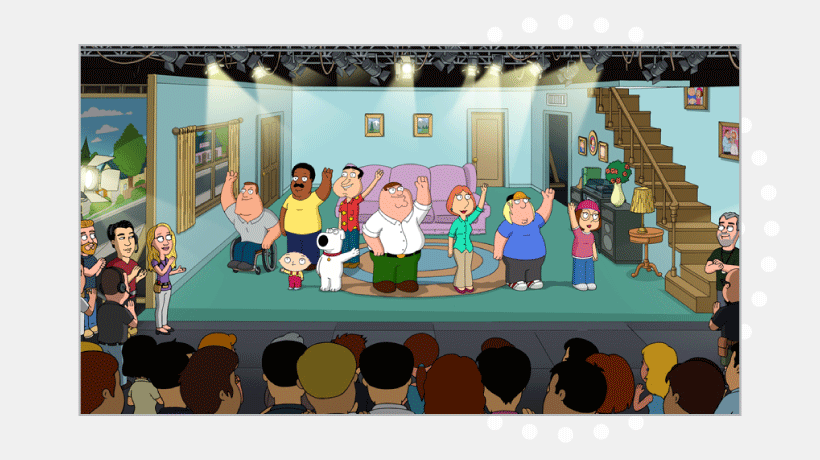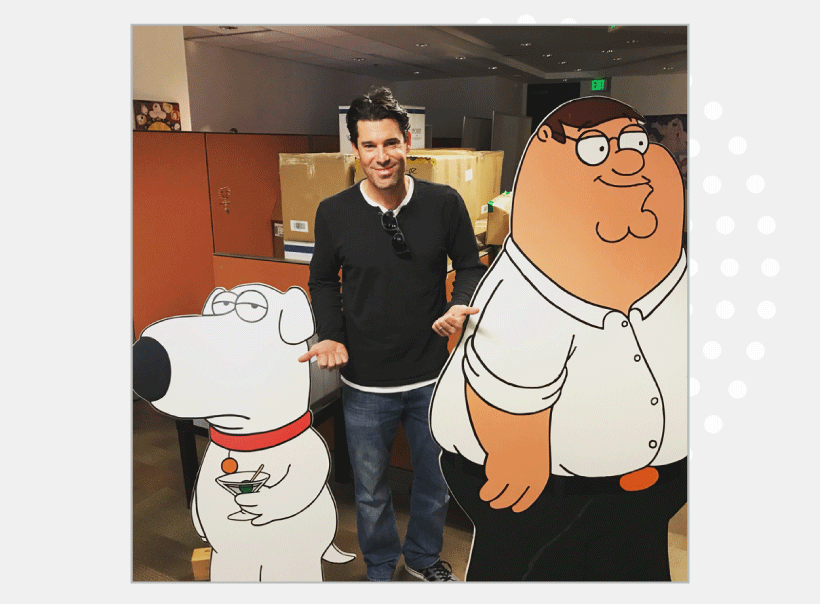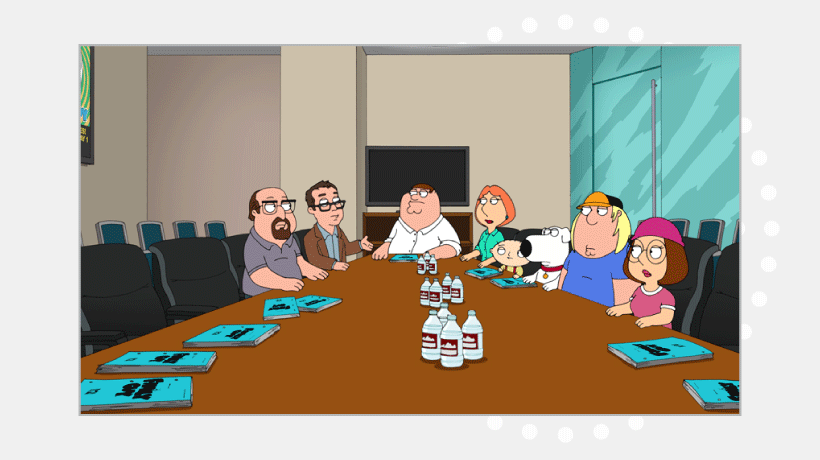
It’s not every day you get to attend a table-read for one of your great TV loves of all-time. But that was me, this past Valentine’s Day, when I was invited to gag central – headquarters for the Emmy Award-winning Fox TV show, ‘Family Guy’. The show itself has been on-air for a miraculous 15 (going on 16) seasons and 300+ episodes, after initially premiering in 1999 and getting cancelled in 2002… before being brought back to life for good in 2005 thanks to undeniable show of fan support.
All told, the show’s gone on to launch the careers of, amongst others, Seth MacFarlane (the show’s creator, who became the youngest show runner in the history of network TV at age 25), Stewie Griffin, Quagmire, Cleveland (who got a spinoff) and has kept a whole gaggle of talented TV writers and producers working as they continue to redefine animated TV comedy in colorful ways. One such gentleman, executive producer Steve Callaghan, has been staffed on ‘Family Guy’ since the beginning, having written 23 episodes and counting to date. He was kind enough to give me a phone interview after the table-read experience.
Prepping for the table-read and pushing your wits
As for the table-reads themselves, they happen once or twice a month when the team’s ready to unveil a new episode for the very first time. It all happens in a big conference room filled with talented staffers doing the actual voices of ‘Family Guy’ characters, at a brisk pace, and most with spot on precision. Overall, it looks something like this, but without animated people:
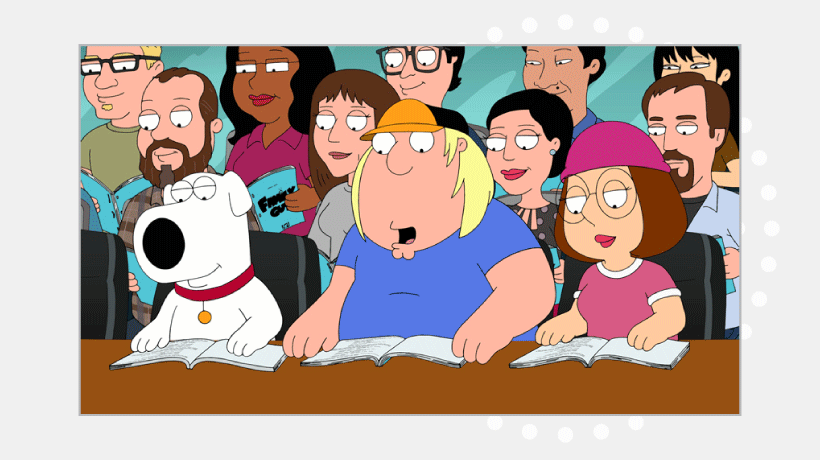
Phones/cameras are not allowed… and on this day, the main voiceover actors for the show, i.e., Mila Kunis, Alex Borstein, Seth Green, and Seth MacFarlane, were not present. (Fairly typical for a show at this stage, given the star power involved.) Regardless, the show’s incredibly talented team of scribes, artists and assistants were there, and these people graciously let me into their world for a day. So in the spirit of sharing with you – the ClearVoice audience – here are some of the most impressive or insightful morsels I gleaned from taking this tour-de-farce of a show once hailed by the New York Times to be “The best satire of all-American dysfunction next to ‘The Simpsons’.” Not. Too. Shabby.
1. If you want to know if something works, put it out there for others to hear.
We all know the famous Ernest Hemingway quote, “Writing is rewriting.” It’s a rule writers live by on a daily basis as they rework the same sentence for the 20th time, twisting words and phrases like a Rubik’s Cube. But what’s the best way to find out what you need to rewrite? Well, in the case of ‘Family Guy’ table-reads, hearing jokes and gags read aloud to a room full of people is a great litmus and essential part of the journey from LOL to ROTFL.
According to Callaghan, “Table reads are a really important part of the process. Especially with a show that’s gone as long as ours has because people who work on the show have a certain sensibility, and it’s important to bring in people from outside the office to bring a freshness and more objective perspective to it – to see if they find it funny the same way we do.”
The ultimate goal being? “Seeing which jokes work, which ones don’t, where things need to be tightened up… Ultimately, we want to make sure the show works and is funny for as many people as possible.”
The lesson: Get your work out there. Sometimes the best perspective is an outside perspective.
2. Collaboration is an important component to keeping things fresh (that, and lots of colored paper).
Callaghan confesses that one of the keys to keeping the writing fresh after 15 seasons is to rely on the team of 20+ writers to help bring a final script to life.
“We have a very talented staff of writers. There’s a group of us who do pretty much all of the writing in a pretty collaborative way,” reveals Callaghan. “One writer will take the lead in terms of writing a first draft of an episode, but by the time it makes its way through the pipeline and through the entire writing process, it will have received the contributions of pretty much almost every writer on our staff, who bring their own experiences, sensibilities and senses of humor to it.”
Callaghan goes on to explain how the process can sometimes unfold at ‘Family Guy’: “After progressing through a rewrite, we might see something that is pretty modular, like a cutaway. We know which character is going to set it up, and we’ll send four to five writers off to one of these satellite rooms, which we’ll call a ‘gag room’. And their task is to basically come up with like six or seven different alternate gags that could go in that spot and come back in and actually pitch them. A lot of our writers have a performance background. So they’ll put on a little song and dance, dog-and-pony show for the rest of us and pitch aloud all the different gags. Hopefully there’s one in there that we really like.”
And if there was any doubt about what goes into each and every episode at ‘Family Guy’, I saw proof in the form of a great wall of scripts during my office tour, care of Seth MacFarlane’s assistant Brad DePrima. Different colors, versions, and episodes, all filled with the blood, sweat and tears from the ‘Family Guy’ writing team. As for what it all means, DePrima broke it all down: “There’s a set color scheme for each stage: record script, animatic and color. Blue, pink, yellow, green, buff, salmon, tan, cherry, orchid, then it recycles for the next stage. It’s like karate. You can tell how far along a script is in each stage.”
Personally, I didn’t realize “buff” was even an actual color, but when you see the wall in person you realize this rainbow of rewrites is indicative of the team’s dedication to collaboration, process and quality control. What DePrima calls “a pretty well-oiled machine at this point.”
The lesson: When you have other good writers at your disposal, don’t compete. Work together. Then, invent colors… like buff.
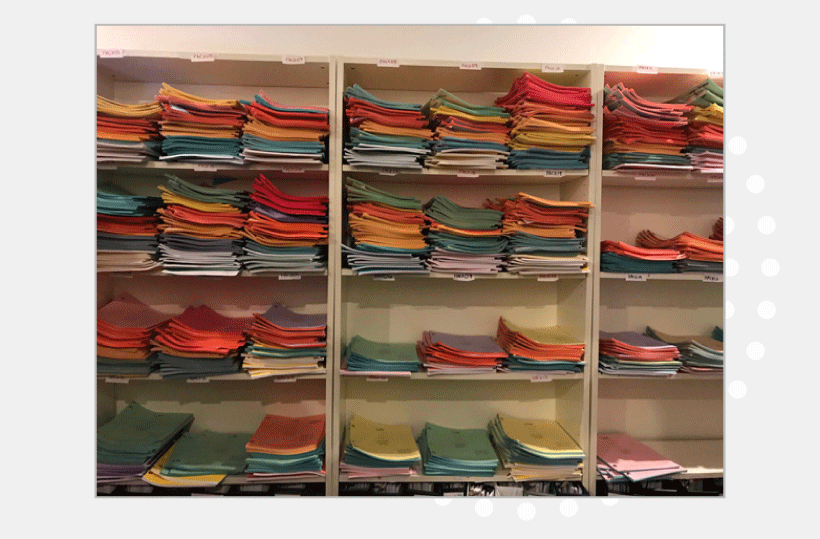
3. A joke has to work in words… and pictures.
Think about it: When you tell a joke at the dinner table, you might say all the words right. But if you fumble the delivery, gesture incorrectly and mess up the timing, you could be caught standing there with your potatoes in your hand.
Same goes for writing, pitching and producing solid jokes for a ‘Family Guy’ episode. As I learned, the whole process of creating an episode takes about a year from the time the script gets written, which includes the time to record voiceovers, draw rough animations, color them (in Korea) and make sure it all fits together back at home and that none of your jokes are stale when it’s ready to air.
One of the most impressive things I saw was a personality playbook for each main character, breaking down every possible facial expression — so that when the animatics get sent to Korea, that team gets a detailed list of which character emotions should be brought to life and when, from smiles, to surprise, to sneers. Only after all of this is done can you see if a joke is truly working.
Regarding the dedication to quality control, Callaghan had this to say. “There are many, many, many, many jokes, some better quality than others that get pitched before we find the one that goes in the script. But then, even having said that, it goes in the script for the moment and then goes through the process of a table-read, an animatic screening, a color screening and gets put to the test multiple times during the little over a year it takes to produce that episode. Sometimes something gets pitched in the room that seems funny at the time, but may die at the table. Or maybe it gets a laugh at the table-read, but then we see it in the animatic and it just doesn’t work as well.”
The Lesson: Write funny gags that also work visually, and you’ll be better off. Like this.
4. Where we’re going there are no rules.
If all TV shows followed a set of guidelines for success (with regards to story, structure and adherence to unspoken rules about society), televised content would feel homogenized at best, and stale and predictable at worst. Luckily for animated adult fare such as ‘Family Guy’, a big middle finger has been extended in the name of predictability. One of the things that’s made ‘Family Guy’ stand the test of time is their hilarious, rule-breaking tangents known as cutaways. A cutaway could manifest itself in a quick aside. Or it could be an epic 5:31-second fight with a chicken that’s has no bearing on the episode’s main plot line… at all.
If you have time to kill, here’s a string of them you can watch.
At the table-read I attended, there are a bunch of funny new cutaway gags with a topical, ripped-from-the-headlines feel. Unfortunately, I can’t talk about them because this episode is still in production and I signed a confidentiality agreement. But, as a main ingredient of the show’s secret sauce, Callaghan had this to say this about their unruly cutaway gags:
“These are very much in the DNA of the show. It’s something that Seth MacFarlane introduced in the pilot episode… and is definitely a part of how he envisioned the structure of the episode playing out. I think it lends itself particularly well to a show like ours that is so dense with jokes. Sometimes the gags go for five seconds or less, and sometimes they go on for minutes at a time. But whereas that might be a little more impractical to do on a live-action show, where you have to build a whole set just to do a five- or 10 second-gag, with animation you can do that. I think it’s something that makes the show fun to watch. It makes it very challenging to write. I’ll tell you that.”
The lesson: Sometimes a five-minute-plus fight sequence with an angry chicken can work if you’ve set up the expectation from the beginning.
5. Don’t be afraid to be fearless.
Whether you’re a writer or Meryl Streep in ‘Sophie’s Choice’, it can be easy to get attached to your babies. After all, that joke or funny gag is a brainchild of yours, so to cast it away forever, never to be heard from again seems counterintuitive to the process of writing. However, as Callaghan reveals, try not to settle for anything mediocre on your way to getting to the best version of the joke. When I asked him about lessons he’s learned along the way, from episode one to the latest one he’s written, here’s what he said:
“I’ve learned many, many, many lessons. One that comes immediately to mind is not only the importance of rewriting, but the importance of being unafraid to just toss out stuff that you think is great. You can always go back to it, but be open to the idea that there’s a better idea still out there. Or a better execution. I think having a fearlessness about rewriting only makes your writing better.”
6. Connect with your fan base early on… and anything is possible.
When you walk around the ‘Family Guy’ production offices, there’s no scarcity of fanfare scattered throughout the office. There’s original art work that’s been created in deference to the show, standees you can take photos with, even a Drunken Clam neon sign fluttering away in the lobby. In other words, not the kind of stuff that gets created if no one gives two sh*ts about your show.
The atmosphere is a virtual museum to the show, and none of it would’ve been possible if fans didn’t dedicate themselves to consuming the show after it was prematurely cancelled in 2002. Callaghan is quick to cite this inspiration as the reason the team is committed to churning out a quality product, every step of the way.
“We just work really hard to try to keep it fresh and hold ourselves to a high standard… A lot of it stems from the fact that we owe a lot to our fans — especially me, as someone who’s worked on the show since the beginning.” Callaghan concludes, “I literally owe my job to our fans because the show was canceled and then brought back from the dead solely because of fan support and people’s willingness to buy DVDs and watch the show on Cartoon Network.”
The lesson learned: Sometimes getting cancelled can be a blessing in disguise. Just make sure your fans are dedicated. And loud.
Sometimes, a gentle nod, a polite wave and a tireless dedication to seemingly endless joke-writing can go a long way.
